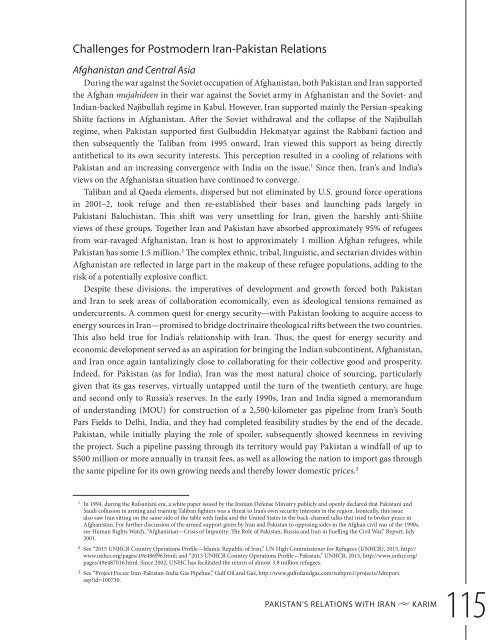pakistan’s
SR55_Mapping_Pakistan_February2016
SR55_Mapping_Pakistan_February2016
You also want an ePaper? Increase the reach of your titles
YUMPU automatically turns print PDFs into web optimized ePapers that Google loves.
Challenges for Postmodern Iran-Pakistan Relations<br />
Afghanistan and Central Asia<br />
During the war against the Soviet occupation of Afghanistan, both Pakistan and Iran supported<br />
the Afghan mujahideen in their war against the Soviet army in Afghanistan and the Soviet- and<br />
Indian-backed Najibullah regime in Kabul. However, Iran supported mainly the Persian-speaking<br />
Shiite factions in Afghanistan. Ater the Soviet withdrawal and the collapse of the Najibullah<br />
regime, when Pakistan supported first Gulbuddin Hekmatyar against the Rabbani faction and<br />
then subsequently the Taliban from 1995 onward, Iran viewed this support as being directly<br />
antithetical to its own security interests. This perception resulted in a cooling of relations with<br />
Pakistan and an increasing convergence with India on the issue. 1 Since then, Iran’s and India’s<br />
views on the Afghanistan situation have continued to converge.<br />
Taliban and al Qaeda elements, dispersed but not eliminated by U.S. ground force operations<br />
in 2001–2, took refuge and then re-established their bases and launching pads largely in<br />
Pakistani Baluchistan. This shit was very unsettling for Iran, given the harshly anti-Shiite<br />
views of these groups. Together Iran and Pakistan have absorbed approximately 95% of refugees<br />
from war-ravaged Afghanistan. Iran is host to approximately 1 million Afghan refugees, while<br />
Pakistan has some 1.5 million. 2 The complex ethnic, tribal, linguistic, and sectarian divides within<br />
Afghanistan are reflected in large part in the makeup of these refugee populations, adding to the<br />
risk of a potentially explosive conflict.<br />
Despite these divisions, the imperatives of development and growth forced both Pakistan<br />
and Iran to seek areas of collaboration economically, even as ideological tensions remained as<br />
undercurrents. A common quest for energy security—with Pakistan looking to acquire access to<br />
energy sources in Iran—promised to bridge doctrinaire theological rits between the two countries.<br />
This also held true for India’s relationship with Iran. Thus, the quest for energy security and<br />
economic development served as an aspiration for bringing the Indian subcontinent, Afghanistan,<br />
and Iran once again tantalizingly close to collaborating for their collective good and prosperity.<br />
Indeed, for Pakistan (as for India), Iran was the most natural choice of sourcing, particularly<br />
given that its gas reserves, virtually untapped until the turn of the twentieth century, are huge<br />
and second only to Russia’s reserves. In the early 1990s, Iran and India signed a memorandum<br />
of understanding (MOU) for construction of a 2,500-kilometer gas pipeline from Iran’s South<br />
Pars Fields to Delhi, India, and they had completed feasibility studies by the end of the decade.<br />
Pakistan, while initially playing the role of spoiler, subsequently showed keenness in reviving<br />
the project. Such a pipeline passing through its territory would pay Pakistan a windfall of up to<br />
$500 million or more annually in transit fees, as well as allowing the nation to import gas through<br />
the same pipeline for its own growing needs and thereby lower domestic prices. 3<br />
1 In 1994, during the Rafsanjani era, a white paper issued by the Iranian Defense Ministry publicly and openly declared that Pakistani and<br />
Saudi collusion in arming and training Taliban fighters was a threat to Iran’s own security interests in the region. Ironically, this issue<br />
also saw Iran sitting on the same side of the table with India and the United States in the back-channel talks that tried to broker peace in<br />
Afghanistan. For further discussion of the armed support given by Iran and Pakistan to opposing sides in the Afghan civil war of the 1990s,<br />
see Human Rights Watch, “Afghanistan—Crisis of Impunity: The Role of Pakistan, Russia and Iran in Fuelling the Civil War,” Report, July<br />
2001.<br />
2 See “2015 UNHCR Country Operations Profile—Islamic Republic of Iran,” UN High Commissioner for Refugees (UNHCR), 2015, http://<br />
www.unhcr.org/pages/49e486f96.html; and “2015 UNHCR Country Operations Profile—Pakistan,” UNHCR, 2015, http://www.unhcr.org/<br />
pages/49e487016.html. Since 2002, UNHC has facilitated the return of almost 3.8 million refugees.<br />
3 See “Project Focus: Iran-Pakistan-India Gas Pipeline,” Gulf Oil and Gas, http://www.gulfoilandgas.com/webpro1/projects/3dreport.<br />
asp?id=100730.<br />
PAKISTAN’S RELATIONS WITH IRAN u KARIM<br />
115



